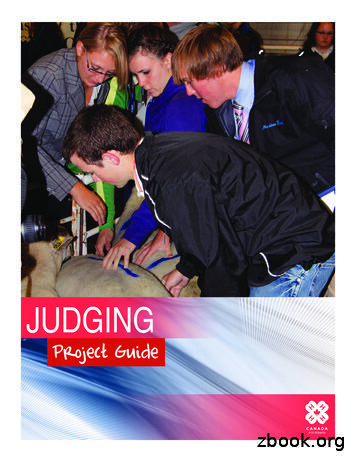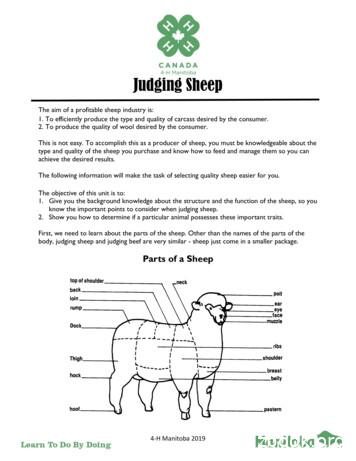Handling, And Judging Risk Of Bias Associated With Missing .
Handling, and judging risk of biasassociated with missing participantdata in meta-analyses of binary andcontinuous outcomesElie Akl, Shanil Ebrahim, Gordon Guyatt
No conflicts of interest to declare This work has been partly funded by theMethods Innovation Fund (MIF)
Objective To develop guidance for systematic reviewauthors on how to handle, and judge risk ofbias associated with missing participant datain meta-analyses of binary and continuousoutcomes
Trial level participant entryTrial level participant flowRandomizedMistakenlyrandomizedTrial level data collectionTrial level data analysisCollectedAppropriatelyexcludedSystematic review level data availabilitySystematic review level data analysisAdherent andfollowed-upExcludeCollectedIncludedLost ilableAccordingto trialanalysisITT, perprotocol oras MissingavailableCCA, or makeassumptions
Proposal to handle MPD For the primary analysis: exclude participantswith missing data (complete case analysis) To assess the risk of bias, and when theprimary analysis suggests important effect, wesuggest sensitivity meta-analyses makingdifferent assumptions about the outcome ofparticipants with missing dataAkl et al. PLoS One. 2013;8(2):e57132
Judging RoB dichotomous MPD Results robust to a worst case scenario missing data does not represent a risk of bias Results not robust to worst case scenario test progressively more extreme assumptionsculminating in a "worst plausible case” Important changes in results with suchsensitivity analyses suggest serious RoB
Example Meta-analysis assessing effects of probioticsfor prevention clostridium difficile-associateddiarrheaNeumann et al. Ann Intern Med. 2012 May 15;156(10)
Complete case analysis
Event rate: 1.5:1
Event rate: 3:1
Event rate: 5:1
Handling continuous MPD Strategies to combine imputations for participants with missingdata with those with complete data Progressively more stringent strategies to challenge estimatesEbrahim et al. J Clin Epidemiol. 2013 Sep;66(9):1014-1021.e1
Imputing effect & precisionMeasure of effect5 sources of data reflecting real observed mean scores inparticipants followed-up in individual trials in a meta-analysis: Ranging from:o Best mean score among intervention armso Worst mean score among control armsMeasure of precision Median SD (plausible)
Imputation strategies Developed 4 progressively more stringent imputation strategiesfor participants with missing data in both armsAssumptions about the means of participants inINTERVENTIONC: Mean score from theD: Worst mean amongcontrol arm of the same trial intervention arms4Intervention: Worst meanamong control armsControl: Best mean amongintervention armsA: Best mean amongintervention armsAssumptionsabout themeans ofparticipants inCONTROL2Intervention: Worst meanamong intervention armsControl: Best meanamong control armsB: Best mean amongthe control armsC: Mean score fromthe control arm of thesame trialE: Worst mean amongcontrol arms1Intervention and control:Mean score from the controlarm of the same trial3Intervention: Worst meanamong control armsControl: Best meanamong control arms
Combining observed & imputed data3-step method for each strategy:[1] Combine observed means and SDs of those with availabledata with imputed means and SDs for those with missing data[2] Use pooled estimates to calculate treatment effect per study[3] Perform a standard random-effects meta-analysis to pool
Application of approach: 1 Cognitive behavioural therapy (CBT) versus minimal or notreatment for depression in patients receiving disability benefits 8 RCTs: Beck Depression Inventory Median missing participant data rate 21% (range 0 to 41%)Ebrahim et al. PLoS One. 2012;7(11):e50202
Application of approach: 2 Finasteride therapy versus placebo on improvement in scalphair for men with androgenetic alopecia 8 RCTs Median missing participant data rate 14% (range 0% to 24%)Mella et al. Arch Dermatol. 2010 Oct;146(10):1141-50.
DiscussionCBT review:o Effect diminished, lost significance as strategies becamemore stringento Rate down for risk of biasFinasteride review:o Even most stringent: effect important, statistical sig remainso Do not need to rate down for risk of bias
Conclusions Approach involving progressively more stringent assumptionsabout results in participants with missing data Provides guidance on rigorously determining the extent towhich missing data increases risk of bias in systematic reviews To the extent that results change with the sensitivity analyses,risk of bias as a result of missing data increases
For the primary analysis: exclude participants with missing data (complete case analysis) To assess the risk of bias, and when the primary analysis suggests important effect, we suggest sensitivity meta-analyses making different assumptions about the outcome of participants with missing
Sep 04, 2020 · Judging Poultry Judging Rabbit Judging Meat Cuts Judging Crop Samples Judging Hay and Haylage Judging Silage Judging Baked Goods Judging Clothing Judging Crafts. . practice, practice and practice some more to become a better judge. Top judges across the country have judged hundreds of classes. In addition they have
National Center for Home Food Preservation Judging Home Preserved Foods - p. 2 Methods of Judging Two major purposes for judging include: 1. To judge the quality of the project or exhibit. Judging the entry involves the objective appraisal of the finished product in a uniform way. 2. To contribute to the learning experience of the exhibitor.
the NE Region Porsche website; www.porschenet.com. No cars will be allowed into the Concours judging area after this time. An owner will be given time to prepare the car for judging with all preparation and cleaning stopped within 15 minutes of the designated time to begin judging. No further cleaning or touching of the car can occur after this
meat removal that is allowed for a C grade. Factors used in judging ready-to-cook carcasses and parts in a 4-H Poultry Judging Contest are: 1. Exposed Flesh 2. Missing Parts 3. Disjointed and Broken Bones Always select your score based on the lowest grade defect found on each carcass or part. Because of the length of most judging contests .
the different judge levels and roles. AAU Jump Rope Scoresheets included at the end of this document. There are currently two levels of AAU Jump Rope Judging: - Level 1: Speed/Power Judging, Freestyle Floor Manager, and Freestyle Presentation Judging. Experienced Level 1 Judges may be trained for Freestyle Head Judge.
Iowa 4-H Livestock Judging Videos 3-12 Video ISU Extension Online 4-H Livestock Judging: Introduction and Leader's Guide Adult Curriculum UF-IFAS EDIS Online 4-H Livestock Judging Activity 1: Parts is Parts 3-12 Curriculum UF-IFAS EDIS Online 4-H Livestock Judging: Activity 2, Different Str
know the important points to consider when judging sheep. 2. Show you how to determine if a particular animal possesses these important traits. First, we need to learn about the parts of the sheep. Other than the names of the parts of the body, judging sheep and judging beef are very similar - sheep just come in a smaller package. Parts of a Sheep
Horse judging contest classes will have four (4) horses per classes. Each horse should be evaluated on its own merit and in relation to the rest of the class. Typical judging procedure for a halter class at a horse judging contest is as follows: 1. Side View (Profile) 2. Front View 3.























